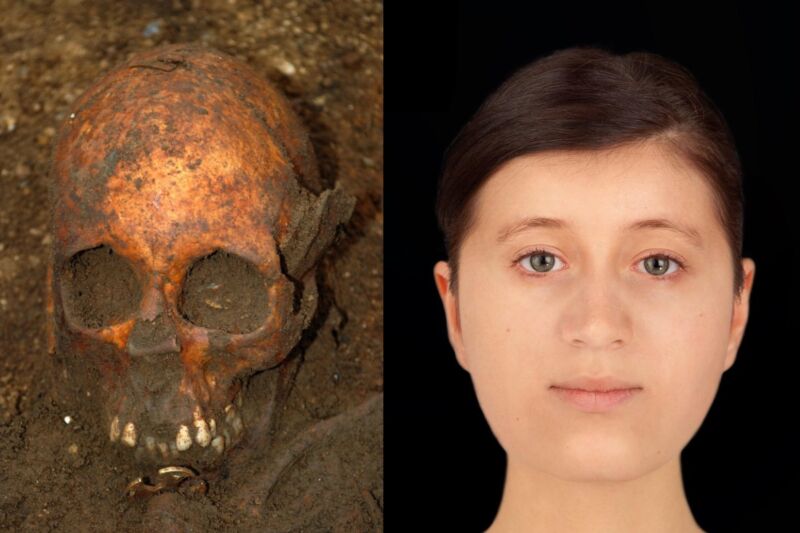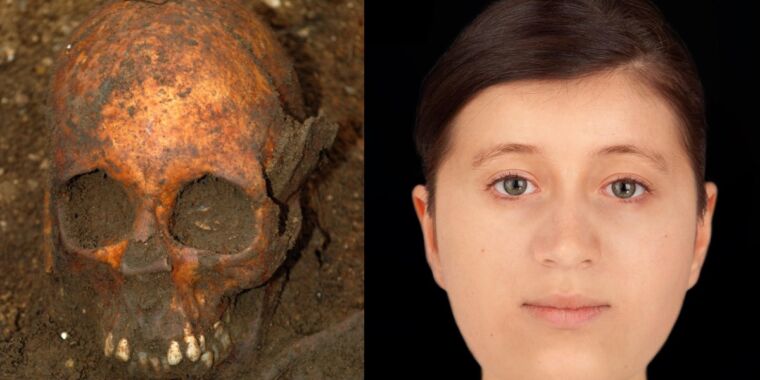
University of Cambridge Archaeological Unit/Hew Morrison ©2023
Earlier this week, archaeologists unveiled the facial reconstruction of the remains of a seventh-century AD Anglo-Saxon teenage girl found in a rare “bed burial” in 2012. It’s part of a new exhibit at the University of Washington’s Museum of Archeology and Anthropology. Cambridge called “Under Our Feet: Archeology of the Cambridge Region.” In addition to the reconstruction, scientists also analyzed the young woman’s bones and teeth to learn more about her diet and geographic region of origin.
The girl would have been about 16 years old when she died. The grave was discovered in a spot near a village called Trumpington, just outside Cambridge. It is one of only 18 so-called “bed burials” – a rare Anglo-Saxon practice, usually reserved for high-status women, in which the deceased was buried on an ornamental bed – discovered in the UK to date. Nearby were three other graves containing two younger women and an older person. This particular bed had a wooden frame held together by metal brackets and looped metal to secure the cross slats, most likely covered with a straw mattress.
Among the grave goods interred with the girl were an iron knife, a chatelaine (decorative belt), glass beads, gold and garnet pins, and most importantly an ornate gold pectoral cross inlaid with garnets, now known as the Trumpington Cross. Archaeologists believe it was sewn onto the robe she was wearing when she died. Such crosses are very rare, and their presence indicated that the young woman was likely a member of the Anglo-Saxon nobility, especially when combined with evidence of the bed burial. The cross indicates she was a Christian, but the grave goods are a pagan custom, so archaeologists consider the find representative of a pivotal period in British history when Christianity was just beginning to spread through the country.
To reconstruct the girl’s face, forensic artist Hew Morrison used measurements of the skull and general tissue depth data, though he had to guess at the precise hair and eye color in the absence of a DNA analysis. The resulting face is notable because the left eye is slightly lower than the right eye, which Morrison said “would have been quite noticeable in life”.
-
The Trumpington Bed Burial was excavated in 2011 in Cambridge, England.
University of Cambridge Archaeological Unit
-
The Trumpington Cross was found during the excavation of the burial in 2012.
University of Cambridge Archaeological Unit
-
The Trumpington Cross, 3.5 cm in diameter and inlaid with garnets.
University of Cambridge Archaeological Unit
-
Gold and garnet pins from the funeral.
University of Cambridge Archaeological Unit
-
Iron fittings from the burial bed on display at the Museum of Archeology and Anthropology in Cambridge.
Earlier research had already shown that the young woman suffered from an illness, although her cause of death was not clear. In addition, isotope analysis suggested that the girl had moved to England around age 7 and that there was a significant decrease in protein in her diet towards the end of her life. Those isotope results match those of two other women found in bed during the same period.
“She was quite a young girl when she moved, probably from part of southern Germany, close to the Alps, to a very flat part of England,” said Cambridge bioarchaeologist Sam Leggett, who conducted the analysis with colleagues Alice Rose and Emma Brownlee. “She was probably quite unwell and she traveled a long way to a place she was completely unfamiliar with – even the food was different. It seems she was part of an elite group of women who probably migrated from mainland Europe in the 7th century. , most likely Germany, have traveled, but they remain a bit of a mystery. Were they political brides or perhaps brides of Christ? The fact that her diet changed when she arrived in England suggests that her lifestyle may have changed quite a bit.”
The Cambridge exhibit will also display the Trumpington Cross and gold and garnet pins found near the girl’s neck, as well as the decorative headboard. Other artifacts on display include pottery and textiles found at a Bronze Age site called “Britain’s Pompeii”; an engraving of an Iron Age man; a recently discovered elephant ivory belt buckle that once belonged to a young Augustinian friar; and a bracelet and pottery dating from just before the Roman invasion of Britain.
2012 video detailing the discovery of a teenage girl’s tomb from the mid-seventh century AD.

